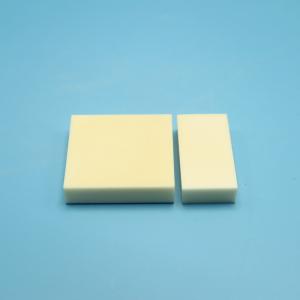
Add to Cart
Aluminum oxide bulletproof ceramic high hardness and high density bulletproof vest body protection
The application of alumina bulletproof ceramics
Aluminum oxide sintered products have a smooth surface, stable size, and low price. According to purity, they are divided into 85/90/95/99 aluminum oxide ceramics, and their corresponding hardness and price also increase sequentially. They can be seen in various armored vehicles and military and police bulletproof suits.
However, in order to ensure a certain strength of the ceramics, 99 alumina ceramics are often used for bulletproof alumina ceramics, and low porosity is ensured during the forming and sintering processes to minimize micro stress concentration. Next, let's take a look at its applications together.
Human body bulletproof vests are commonly used protective equipment for individual soldiers, armed police, security personnel, and armed escorts, and are dual-use products for both military and civilian use. The core component of human body bulletproof vests is the bulletproof insert plate. The insert plate material has gone through hard metal insert plates and soft synthetic fiber insert plates, and has now developed to the third generation of ceramic/synthetic fiber composite insert plates, which is currently the main development direction of bulletproof vests.
The bulletproof insert board is mainly divided into two parts. The first is the insert board back board made of aramid or ultra-high molecular weight high-strength high modulus polyethylene fiber composite materials; The second is a bulletproof panel made from aluminum oxide, silicon carbide, and boron carbide as raw materials. The combination of the two is achieved through a transitional bonding layer, and a layer of crack stopping cloth is pasted on the surface of the ceramic panel to prevent damage to the human body when the ceramic is broken, resulting in the third-generation composite bulletproof insert plate.
As mentioned earlier, aluminum oxide has a high density and is relatively heavy. In order to make bulletproof vests lighter and more conducive to people's activities, processes such as injection molding can be used to make aluminum oxide bulletproof ceramic plates conform to the curve of the human body, while also reducing the weight of the bulletproof ceramic plates, which is beneficial for the human body to wear and more comfortable to wear.
Compared with the previous mainstream method of using small piece splicing technology to paste ceramic tiles onto the ceramic insert board manufactured on the back board, this curved alumina ceramic board can avoid the defects caused by the elimination of splicing joints in previous products, improve the bulletproof safety factor, and at the same time, the uniformity of the internal material of the ceramic tiles is also better.
products index:
| Ceramic characteristic table | |||
| name | 99% ceramics | 95% ceramics | |
| physical propertyessential component | essential component | AL2O3≥99% | AL2O3≥95% |
| Density(g/cm3) | 3.85 | 3.6 | |
| water absorption% | 0 | 0 | |
| sintering temperature | 1690 | 1670 | |
| material characters | Hardness(HV) | 1700 | 1600 |
| break off strength | >6500 | >2900 | |
| compressive strength | 30000 | 25000 | |
| thermal response | maximum service tempera- ture | 1500 | 1400 |
| thermal expansion coefficient | 8 | 7.8 | |
| 10-6/℃ | |||
| 0-1000℃ | |||
| Heat shock resistance T(℃) | 200 | 220 | |
| thermal conductivity W/m.k | 31 | 22 | |
| electrical specification | volume resistivity Ω.cm | >1012 | >1012 |
| Insulation destructive power KT/m | 18 | 16 | |
Company workshop equipment:


